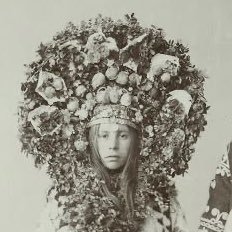Original Polish title, ‘Gusła Słowian’, uses the archaic Polish word ‘gusła’ - a hard-to-translate concept comprising magic and rituals (mostly of shamanic nature)
The illustrations include also the artist’s interpretations of old-Slavic gods (lesser/local deities as well as the major gods and goddesses)
The paintings show some of the most practiced Slavic rituals of pagan origin that survived to the modern era
Baba Yaga is considered one of the most memorable and distinctive figures in Eastern European folklore while playing both the role of a donor, as well as the villain
Traditionally, early in the morning boys awake girls by pouring a bucket of water on their head and striking them about the legs with long thin twigs or switches made from willow, birch or decorated tree branches
Her name is associated with Söyembikä Tower which is one of the most familiar landmarks and architectural symbols of Kazan
Ukrainian Cossacks came from a variety of nationalities and social groups. Their ancestors came from Ukrainian, Russian, Polish, and Tatar territories and migrated at great risk to the southern steppes

























